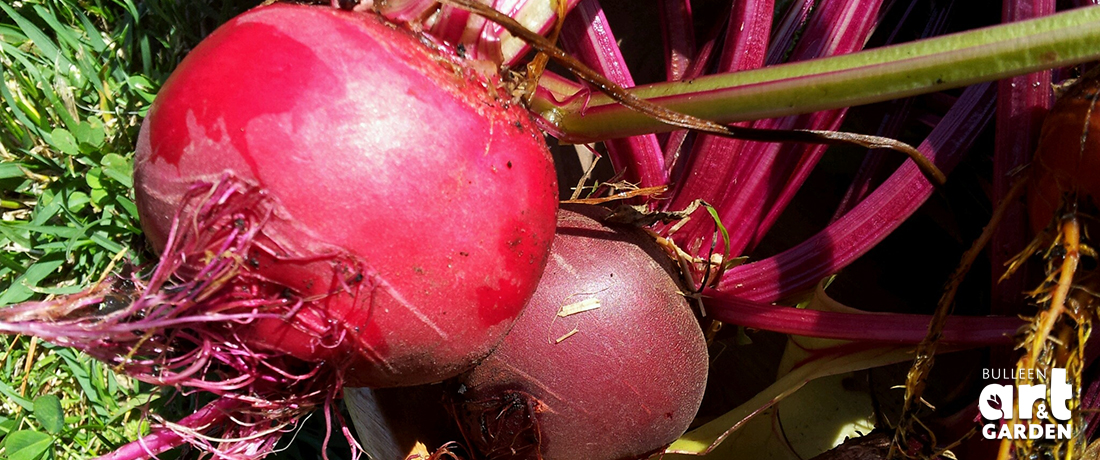
 Important note about plant availability. Important note about plant availability.There are hundreds of factsheets on our website provided for your information. Not all plants will be available at all times throughout the year. To confirm availability please call (03) 8850 3030 and ask for the nursery. |
Beetroot is so simple to grow in your vegie patch and, without doubt, home-grown beets taste ten times better than the canned stuff. Beetroots are chock full of betaine, a great assistant in maintaining cardio-vascular health. A known anti-oxidant, beetroots are also reported to increase “sex drive”, an unlikely result from a fairly unsexy vegie!
Planting Time: July – April
Position: Full sun – part shade
Water Needs: Moderate
Difficulty: Easy
How Long: 10 weeks + (except baby beets)
Some saucy varieties include:
Baby Beets: As the name suggests, these beetroots are sweet, small and quick to mature. Best results and flavour is obtained by pulling from ground quite young.
Chioggia: An unusual heirloom variety with red and white concentric striped flesh. Impress your mates with this one!
Derwent Globe: An incredibly popular variety, Derwent Globe is a deep red, globe shaped beetroot, grown for its tender flesh and sweet flavour.
Golden: Sweet and tasty, these beetroots with golden flesh do not bleed, and are quick to mature.
Position-wise, beetroots aren’t overly fussy. They’ll tolerate full sun to part shade and even do fairly well in dappled light under a deep rooted tree. Beets do beautifully in containers, especially the polystyrene fruit boxes you get from your green grocers
Like most root vegies beetroots need a rich, well-drained soil, chock full of organic matter like compost and manures. Drainage is the key so, if you’re faced with a heavy, clay soil, improve its structure with lashings of delicious compost! And maybe consider putting in some raised beds.
Just like carrots, beetroots tend to do best if planted from seed rather than seedlings. The seed itself is a weird looking “cluster” of a few true seeds in a corky coating. Unlike carrots though, these seeds will benefit from a soak in water overnight… you’ll get better results, and it’s worth the extra effort.
To plant the seeds, make a 2cm deep trench, and pop them in about 2cm apart. Cover the seeds lightly with seed raising mix or a fluffy compost. Keep the area damp (not soaking wet) and in about two weeks your baby beets will appear. You will probably find you need to thin them out, so do this by spreading and removing beets so that there is around 6 – 8cm between each beet plant. This will give them the personal space they need to grow!
The faster beetroot grows the tastier and more tender it will be. The key to this is feeding. At planting time, add some organic chook-poo based pellets to give your beets a kick along. Follow this up periodically with a drink of seaweed-based fertilisers as these contain everything needed for good healthy roots. As with all root vegies, fertilisers high in nitrogen are unnecessary and totally counter-productive. Nitrogen puts on top leaf growth but does nothing for the roots beneath.
Water deeply and keep the soil around emerging seedlings damp. Regular watering will help keep the beets from going woody but don’t flood them.
Beetroot, as root vegies go, is one of the most obliging in terms of letting you know when it’s ready to harvest. This is because you can see beetroot crown above the soil surface. This makes it dead easy to assess the size of your beets and harvest when appropriate. As a rough guide beets grown from seed are ready to roll from about ten weeks onward, depending on the size of the beets required. Make sure you harvest them before they get too big – I generally remove mine before they are 6-7cm across, otherwise the flavour can be compromised.
Beetroots are amazingly pest free especially in a diverse, well-monitored patch. The only thing that will really knock them for six is too much water at an early age. Really wet soil leads to what’s known as “damping off”, a highly technical term that explains why seedlings fail. Essentially it’s a fungal disease that thrives in cold, wet soil, and picks on the weak and vulnerable e.g. seeds and seedlings. As they say, timing is everything, so plant beets when soil is warming and the wet season has well and truly passed.
When harvesting, leave a bit of stalk (about 3cm) attached to the beetroot. This makes them much easier to handle, especially when storing and cooking and means you won’t hurt their delicate skin and make them bleed. Second tip is that the leaves can be eaten! They make an awesome, colourful addition to really boring leafy salads! Go on, make your mates green with envy!
